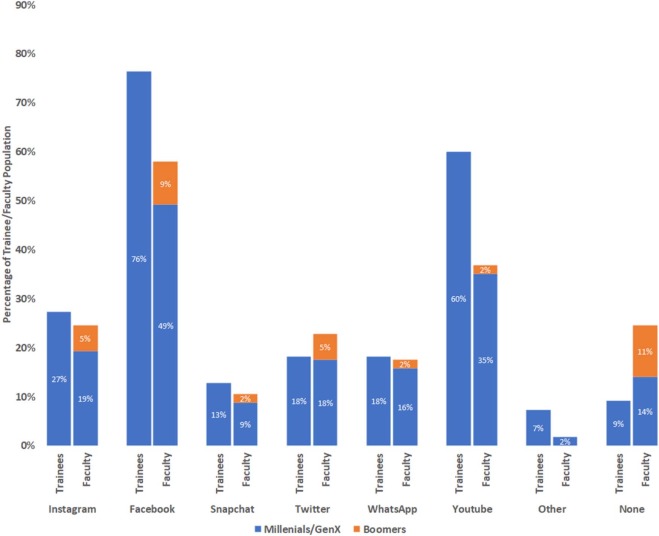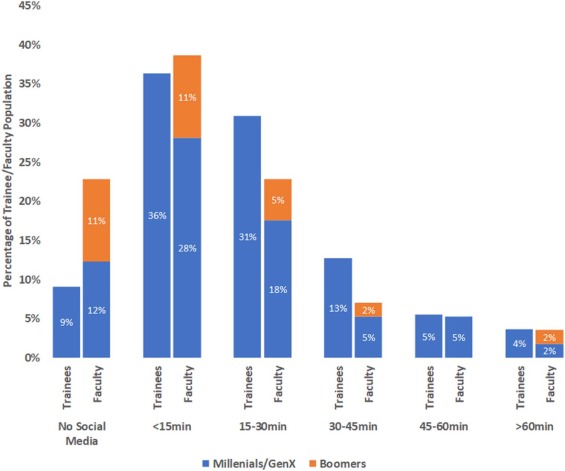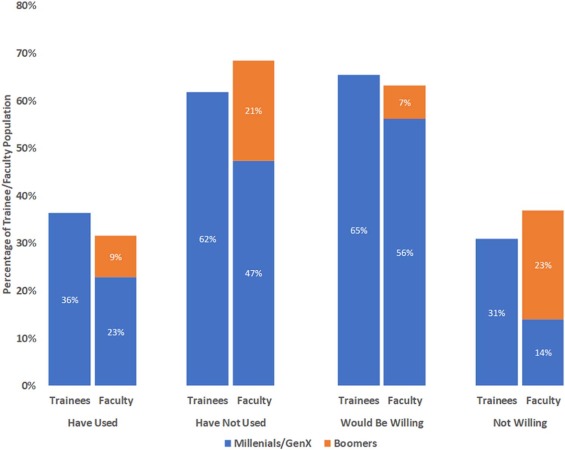Rationale and Objectives
We report social media (SoMe) utilization trends at an academic radiology department, highlighting differences between trainees and faculty and between Baby Boomers versus Generation X and Millennials.
Materials and Methods
An anonymous online survey regarding SoMe utilization and SoMe-based educational curriculum was distributed to all radiologists (trainees and faculty) in our department. Regular chi-square, ordered (Mantel-Haenszel) chi-square, and Fischer exact tests were performed.
Results
The survey instrument was sent to 172 radiologists with a 65% completion rate ( N = 112). Eighty-three percent ( n = 92) of the respondents use SoMe, with Facebook (67%, n = 75), YouTube (57%, n = 64), Instagram (26%, n = 29), and Twitter (21%, n = 23) as the most commonly used platforms. Eighty-one percent ( n = 91) use SoMe for 30 minutes or less per day. Thirty-five percent ( n = 39) reported previously using SoMe for educational purposes, although 66% ( n = 73) would be willing to join SoMe for educational activities. The faculty are more likely than trainees to avoid using SoMe (30% vs 9%, P < 0.03). Trainees are more likely than faculty to find an electronic case-based curriculum valuable (95% vs 83%, P < 0.05) and are willing to spend more time on cases ( P < 0.01). Baby Boomers are less interested in joining SoMe for educational activities than Generation X and Millennials (24% vs 73%, P = 0.0001).
Conclusions
Generation gaps between trainees and faculty, as well as between Generation X and Millennials versus Baby Boomers, exist with regard to the use of SoMe, which may be underutilized in radiology education.
Introduction
Social media (SoMe) is pervasive in modern life. Recent data from the Pew Research Center suggests that 85% of adults in the United States are now Internet users, a sizeable proportion of which utilize one or more SoMe applications (apps), such as Facebook ( facebook.com , Menlo Park, CA), Twitter ( twitter.com , San Francisco, CA), YouTube ( youtube.com , San Bruno, CA), Instagram ( instagram.com , Menlo Park, CA), Snapchat ( snapchat.com , Venice, CA), or WhatsApp ( whatsapp.com , Mountain View, CA) . This rate of utilization has grown dramatically over the past decade, with 65% of American adults now using SoMe, up from just 7% in 2005 . Although the usage of several SoMe platforms has begun leveling off over the past couple years, utilization continues to hold steady, particularly among young adults .
In recent years, SoMe use has gained substantial traction in the medical community. In radiology, it has been promoted as a successful tool to increase the visibility of radiology departments ; to promote research and academic endeavors on a national or international stage ; to engage radiologists within departments ; to increase readership and grow audiences of medical journals ; and to foster relationships between radiologists, referring physicians, and patients . In fact, some data suggest that private practice radiology practices have embraced SoMe more fervently and effectively than academic radiology practices .
Get Radiology Tree app to read full this article<
Get Radiology Tree app to read full this article<
Materials and Methods
Get Radiology Tree app to read full this article<
Survey
Get Radiology Tree app to read full this article<
Data Collection
Get Radiology Tree app to read full this article<
Statistical Analysis
Get Radiology Tree app to read full this article<
Results
Respondent Demographics
Get Radiology Tree app to read full this article<
TABLE 1
Demographics of Social Media Use Survey Respondents
Level of Training Percent of Total, % ( n ) First-year resident (PGY-2) 8.9 (10) Second-year resident (PGY-3) 10.7 (12) Third-year resident (PGY-4) 8.9 (10) Fourth-year resident (PGY-5) 9.8 (11) Radiology fellow (PGY-6+) 10.7 (12) Radiology faculty 50.9 (57) Total respondents_N_ = 112
Generation Percent of Total, % ( n ) Generation X + Millennials \* 84.7 (94) Baby Boomers † 15.3 (17) Total respondents_N_ = 111 ‡
PGY, postgraduate year.
Get Radiology Tree app to read full this article<
Get Radiology Tree app to read full this article<
Get Radiology Tree app to read full this article<
Get Radiology Tree app to read full this article<
SoMe Utilization
Get Radiology Tree app to read full this article<
Get Radiology Tree app to read full this article<
Respondent Educational Content Preferences
Get Radiology Tree app to read full this article<
Trainees vs Faculty
Get Radiology Tree app to read full this article<
Generation X and Millennials vs Baby Boomers
Get Radiology Tree app to read full this article<
Discussion
Get Radiology Tree app to read full this article<
Get Radiology Tree app to read full this article<
Get Radiology Tree app to read full this article<
Get Radiology Tree app to read full this article<
Get Radiology Tree app to read full this article<
Conclusions
Get Radiology Tree app to read full this article<
Appendix
Social Media Utilization Survey
Get Radiology Tree app to read full this article<
Get Radiology Tree app to read full this article<
Get Radiology Tree app to read full this article<
Get Radiology Tree app to read full this article<
Get Radiology Tree app to read full this article<
Get Radiology Tree app to read full this article<
Get Radiology Tree app to read full this article<
Get Radiology Tree app to read full this article<
Get Radiology Tree app to read full this article<
Get Radiology Tree app to read full this article<
Get Radiology Tree app to read full this article<
Get Radiology Tree app to read full this article<
Get Radiology Tree app to read full this article<
References
1. Duggan M.: Mobile messaging and social media—2015.2015.Pew Research Center Available at: http://www.pewinternet.org/2015/08/19/mobile-messaging-and-social-media-2015/
2. Perrin A.: Social media usage: 2005–2015.2015.Pew Research Center Available at: http://www.pewinternet.org/2015/10/08/2015/Social-Networking-Usage-2005-2015/
3. Prabhu V., Rosenkrantz A.B.: Enriched audience engagement through Twitter: should more academic radiology departments seize the opportunity?. J Am Coll Radiol 2015; 12: pp. 756-759.
4. Ranschaert E.R., van Ooijen P.M., Lee S., et. al.: Social media for radiologists: an introduction. Insights Imaging 2015; 6: pp. 741-752.
5. Hoang J.K., McCall J., Dixon A.F., et. al.: Using social media to share your radiology research: how effective is a blog post?. J Am Coll Radiol 2015; 12: pp. 760-765.
6. Bunch P.M., Wortman J.R., Andriole K.P.: Social media and scientific meetings: education exhibit “likes” at the radiological society of North America annual meeting. Acad Radiol 2016; 23: pp. 382-388.
7. Hawkins C.M., Duszak R., Rawson J.V.: Social media in radiology: early trends in Twitter microblogging at radiology’s largest international meeting. J Am Coll Radiol 2014; 11: pp. 387-390.
8. Hawkins C.M., Hillman B.J., Carlos R.C., et. al.: The impact of social media on readership of a peer-reviewed medical journal. J Am Coll Radiol 2014; 11: pp. 1038-1043.
9. Glover M., Choy G., Boland G.W., et. al.: Radiology and social media: are private practice radiology groups more social than academic radiology departments?. J Am Coll Radiol 2015; 12: pp. 513-518.
10. Klee D., Covey C., Zhong L.: Social media beliefs and usage among family medicine residents and practicing family physicians. Fam Med 2015; 47: pp. 222-226.
11. Pearson D., Cooney R., Bond M.C.: Recommendations from the Council of Residency Directors (CORD) Social Media Committee on the role of social media in residency education and strategies on implementation. West J Emerg Med 2015; 16: pp. 510-515.
12. Galiatsatos P., Porto-Carreiro F., Hayashi J., et. al.: The use of social media to supplement resident medical education—the SMART-ME initiative. Med Educ Online 2016; 21: pp. 29332.
13. Bosslet G.T., Torke A.M., Hickman S.E., et. al.: The patient-doctor relationship and online social networks: results of a national survey. J Gen Intern Med 2011; 26: pp. 1168-1174.
14. Avci K., Celikden S.G., Eren S., et. al.: Assessment of medical students’ attitudes on social media use in medicine: a cross-sectional study. BMC Med Educ 2015; 15: pp. 18.
15. Bump P.: Here is when each generation begins and ends, according to facts. The Atlantic; March 25; Available at: https://www.theatlantic.com/national/archive/2014/03/here-is-when-each-generation-begins-and-ends-according-to-facts/359589/
16. Lefebvre C., Mesner J., Stopyra J., et. al.: Social media in professional medicine: new resident perceptions and practices. J Med Internet Res 2016; 18: pp. e119.
17. Cheston C.C., Flickinger T.E., Chisolm M.S.: Social media use in medical education: a systematic review. Acad Med 2013; 88: pp. 893-901.
18. Gonzalez S.M., Gadbury-Amyot C.C.: Using Twitter for teaching and learning in an oral and maxillofacial radiology course. J Dent Educ 2016; 80: pp. 149-155.
19. Hennessy C.M., Kirkpatrick E., Smith C.F., et. al.: Social media and anatomy education: using twitter to enhance the student learning experience in anatomy. Anat Sci Educ 2016; 9: pp. 505-515.


